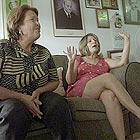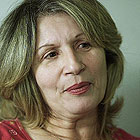|
 |
|
Esta página no está disponible en español. THE ORLANDO SENTINEL Anger At Island's 'Pill' Test Lingers Some women were unwitting subjects of birth control in 1950s and '60s Puerto Rico. By Ray Quintanilla | Sentinel Staff Writer April 5, 2004
HUMACAO, Puerto Rico -- When Delia Mestre was a young woman, a hospital social worker would visit families throughout her barrio, offering the women something that seemed too good to be true: A tiny tablet to keep them from getting pregnant. "We all jumped on it quickly and didn't look back," Mestre, 60, recalled. "Women were told this was medicine that would keep them from having children they couldn't support." Nearly a half-century has passed since doctors began arriving here to begin the longest-running experiment of its kind: nine years of veiled research that helped pave the way for a "magic pill" now regarded as one of the pivotal social and medical changes of the 20th century. What unfolded from the mid-1950s to the early 1960s in this remote farming town in the foothills near Puerto Rico's east coast made Mestre and hundreds of other women the unwitting pioneers of the modern sexual revolution. It remains one of the most controversial chapters in the island's history -- notably because participants weren't informed that they were guinea pigs in an experiment to test the world's first birth-control pill, a tablet with three times as much hormones as today's version. There were other test groups on the mainland at the time, but similar experiments in Boston and other cities didn't last very long, partly because of the pill's side effects. In Humacao, the testing went on for years.
It's difficult to think of those days, said Mestre, among the last generation of Humacao women who took part in the clinical trials of Enovid and a collection of similar drugs that have come to be known universally as "the pill." Generations later, bitter feelings still simmer. Secrecy about the experimental nature of the pills helped prompt federal officials to ban such practices. "The experiments were both good and bad. Why didn't anyone let us make some decisions for ourselves?" she asked, her eyes welling with tears. "I have difficulty explaining that time to my own grown children. "I have very mixed feelings about the entire thing." New recruits Humacao is a gritty village tucked between the Cerro and Labarbera mountains. It was here that doctors found their best "control group," starting in 1955. The doctors provided hundreds of women -- descendents of Puerto Rico's jíbaro agricultural underclass -- with refined versions of the pill for free until 1964 to test its safety and how well it worked. In the early days, the doctor who ran the tests noted publicly, two seemingly healthy women participating in the trials died. No autopsies were done to determine what caused their deaths. Those who remember the times best recall U.S. doctors, dressed in white lab coats, arriving to deliver their babies. Soon, however, they were recruiting women to try the drug. Doctors first sought to study the pill in suburban San Juan, but when most of the women complained of side effects ranging from headaches to depression, many stopped taking it. Humacao, 35 miles southeast, then became home to the clinical trials at the invitation of a local physician. Margaret Sanger, the women's activist who in the 1930s first envisioned a "magic pill" to prevent pregnancy, reportedly visited doctors in the town to lend moral support. In no time, new mothers at Ryder Memorial Hospital were accepting birth-control pills. Physicians dispatched their assistants to rap on doors throughout the town's slums, telling women they didn't have to have another child if they took the pills regularly. That's how many of the test recruits were found, said Conchita Santos, 80, a Humacao resident her entire life. It was only a few years after Puerto Rico became a U.S. commonwealth that doctors began seeking people to test their pills in these neighborhoods -- barrios of small concrete homes where chickens roam and some people still get around on horseback. Santos and other Roman Catholic women were warned by their parish priests not to take the pills. It was not only a sin, they were told, but it also altered God's will. Santos, a homemaker, accepted her first package of pills in 1955, shortly after the birth of her first and only child. "You have to do what's best for you and your family," Santos said, her strong voice turning soft to a whisper. "It's not easy making a choice like that. It was a long time ago, and I've put that entire time to rest." By the end of 1957, doctors at Ryder had recruited about 500 participants. 'Timing was right' Salvador Abreu, author of four books on Humacao, said the clinical trials still elicit hard feelings among Puerto Rican women. For others, he said, they were happy for anything to keep from having so many children. Families of six or more children were common, and when the youngsters were grown, most would go to the sugar-cane fields to work. It was also a time of great poverty. Most homes had no indoor plumbing, and malnutrition was a problem among children. The island's leaders were encouraging residents to seek jobs in the United States as part of Operation Bootstrap. People in Humacao were told their town had five times too many people, Abreu said. "The timing was right for the testing here. Too many people," said Abreu, now 83. "I personally saw the director of the trials helping women and making sure they received medical care. And she would give them the pills if they wanted them." His wife was one of them. "We had one child. That was the idea," he said. "Keep the size of the family small." Abreu, who has lived much of his life here, said most participants have either died or moved away. But when doctors began arriving here, they found adolescent girls who were already mothers, he said. Most had few prospects -- many were illiterate. Some of them, however, now derisively remark about the period, saying the island has endured the decline of U.S. interest in three of its once vital "commodities": sugar, coffee and a woman's ovaries. Suzanne White Junod, the U.S. Food and Drug Administration's historian, said Puerto Rico's women were desperate for birth control when the first pills hit the island. Subsequently, the women learned to tolerate the pill's side effects, which included depression and other assorted aches and pains -- many of which have never been completely chronicled from those early days. "Many Puerto Rican women eagerly agreed to participate in the first clinical trials," Junod said, noting that some already had decided to be sterilized. "Moreover, they were more willing to put up with the noxious side effects than women in similar trials in the United States." Safety issues The FDA cleared the pill for use as birth control in May 1960 and, almost immediately, issues about safety were being raised and centered on blood clotting. Versions of the pill continued to be tested here until 1964, largely because women in the mainland United States were complaining about side effects, Junod said. According to writings of Dr. Adaline Satterthwaite, the trial's director here, the early pill was packed with far more hormones than the version marketed today. In one of her last public speeches, Satterthwaite said she had invited the team of researchers to Humacao because "an acceptable, effective and reversible method of birth control was a high priority, and I believed that we should embark on these studies." Satterthwaite, now 87, resides in a Pennsylvania convalescent center and is in ill health. She hasn't been able to grant an interview for five years, her son said. Critics in Puerto Rico have compared the early pill experiments to the U.S. government's surreptitious syphilis tests on black men in Tuskegee, Ala., about the same time. Nearly as soon as the birth-control pill became available, U.S. women were complaining of such problems as depression, acne, painful periods and others. By 1970, the pill was being linked to fatal strokes, heart attacks and blood clotting among women, and congressional hearings soon followed. Even today, synthetic hormones remain controversial, with some studies linking birth-control pills to higher risks of certain cancers. But the tests here did meet the standards for the time. FDA officials say the rules governing such testing today hardly resemble the standards for that era. Adding to the government's hands-off posture in Puerto Rico was that the testing there involved a drug that already had been approved to treat menstruation disorders. Not for birth control, however. FDA officials say the Humacao experiments led to stronger rules and guidelines for future clinical trials and became the underpinning for a law requiring every participant to be fully informed of the scope of tests before agreeing to participate. Feeling duped Before the pill's inventors got together with Satterthwaite, she said, the two doctors had been injecting synthetic estrogen and progesterone into mice and rabbits to see whether hormones stopped ovulation. A short time later, the doctors arrived in Puerto Rico. "There was never a problem for me, " said Nancy Cruz, 54, who began taking the pill as a teenager and is now a homemaker and mother of four grown children she conceived after going off the pill. "I started on them when I was young, and they worked. My first child came along because I wasn't following directions," she said, recalling what she described as a "daring" time in her life. It wasn't until the 1970s that Cruz learned she and many of her friends had been subjects of an experiment. At first, she felt let down, she said. Then her feelings turned to disappointment, hurt and finally hostility. In a speech in the late 1990s, Satterthwaite expressed regret about one aspect of experiments under her direction. Much to the chagrin of her patients here, however, it had little to do with them. "I have wondered whether the development of the oral-contraceptive pills may also have resulted in the sexual freedom responsible for breakdown of the very family which I sought to defend," Satterthwaite said. Cruz, who recalls suffering from cramps, bleeding and depression when she was taking the pills, said she wonders why participants weren't fully informed -- and why there was never any formal follow-up. Today, she feels as if she were duped, and has never shared her experiences with her children. "With so many of my friends gone now, it makes you wonder whether any of them might have had health problems," she said. "We'll never know."
|

 ----------
---------- ----------
----------